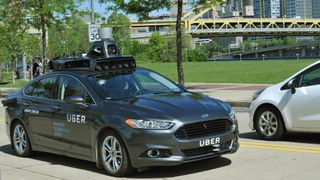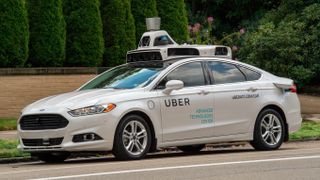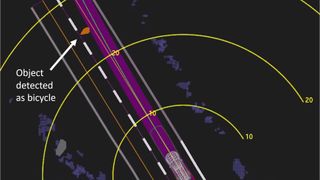Uber self-driving cars: everything you need to know
An uneasy mix of innovation and controversy

200: the number of minivans in Uber's current automated fleet
24,000: the number of SUVs recently purchased from Volvo
1 million+: the number of miles driven on public roads
4: the number of cities where Uber automated cars are being tested
Update: The National Transportation Safety Board (NTSB) has issued its preliminary report into the fatal accident involving an Uber self-driving car and a pedestrian in Arizona that happened in March.
The preliminary NTSB report reveals that while the self-driving car had an automatic emergency braking feature, this was disabled because the car was in "computer mode."
Uber disables emergency braking to prevent erratic driving behavior, according to the NTSB report, citing the ride-hailing service.
Though the car detected it needed to make an emergency braking maneuver 1.3 seconds before it struck the pedestrian who later died of her injuries, the system doesn't alert the driver to take control of the vehicle.
The report was issued one day after Uber announced it was shutting down its self-driving car program in Arizona.
You can read more on what's in the initial NTSB report here.
Original article continues below...
Get daily insight, inspiration and deals in your inbox
Get the hottest deals available in your inbox plus news, reviews, opinion, analysis and more from the TechRadar team.
Uber started out as a service that was as appealing to potential drivers as it was to urban passengers weary of cabs: with your own car and some spare time, you could make some cash by ferrying folks to where they needed to go.
Lately, though, Uber has set its sights on replacing human drivers through its self-driving car program.
Few other firms have embraced this initiative with as much zeal and resources, and the San Francisco-based company had self-driving cars on public streets well before some of its most prominent competitors.
Below, we've compiled everything you need to know about Uber's self-driving car initiative.
How did it all start?
Following months of rumors and vocal support for automation on Uber's part, Uber first announced its intentions to amass a fleet of automatic cars in February 2015, which happened to be the same week that Google announced its own interest in autonomous car technology. (Pay attention, kiddos, for this is important later on.) Shortly after, Arizona Governor Doug Ducey invited Uber to test its cars in the state.
Initially, though, the project kicked off in Pittsburgh, Pennsylvania, where Uber had hired a bunch of researchers from Carnegie Mellon University and helped revitalize Pittsburgh’s Strip district with the opening of the company’s Advanced Technologies Center.
Uber’s initial fleet included 20 Ford Fusions, which seemed like a whole armada back when autonomous cars still felt like science fiction.

The cars themselves were packed with around 20 cameras, seven lasers, a GPS, radar and lidar, a technology that measures the distance reached by outgoing lasers so cars can “see” and interpret the action around them.
Uber quickly began showing off its cars to reporters on trips throughout Pittsburgh, but in every case the car had a "safety driver" that would grab the wheel if things got rough.
Tests and accidents
Following the first experiments with the Ford Fusions, the Volvo XC90 became the vehicle of choice for automation in Uber's first rides on the streets of Pittsburgh.
Initially Pittsburgh mayor Bill Peduto welcomed Uber and its 100 Volvos with open arms, claiming that it was necessary to roll out the red carpet rather than red tape for Pittsburgh to "be a 21st-century laboratory for technology."
Uber took advantage of the relative freedom to dive into testing in Pittsburgh at full strength, even to the point of building a fake city called Almono outside town to test cars before unleashing them in the Steel City.
Even so, the early months were full of light collisions and traffic violations.

The relationship between Pittsburgh and Uber soured quickly. As The New York Times reports, Peduto didn't get any written agreement from Uber, which came back to haunt him and the city.
Uber started charging fees for autonomous car rides, even though Peduto was under the impression that the rides would be free, and the company withdrew support for a $50 million grant meant to revitalize Pittsburgh's local transportation.
For that matter, Uber's presence didn't create jobs on the level that Peduto had apparently expected. The relationship has improved as of late, but it's still rough.
Uber also started testing 16 automated cars in its hometown of San Francisco in December 2016, but as Ars Technica reports, the California Department of Motor Vehicles quickly revoked the registration for the vehicles because Uber refused to secure a special permit that would register them as test vehicles. (Uber's automated tests eventually returned to San Francisco in May 2017.)
Undaunted, the same month Uber started tests in the neighboring state of Arizona, on the streets of Tempe.
In March 2017, one of Uber's automated car was in a crash in Tempe, although blame fell on the human driver of another car for not yielding the right of way. Uber briefly suspended its fleet in order to investigate. A later crash happened in September, but, again, human error was involved.
In late 2017, Uber extended its tests to Canada, and set two automated cars on the streets of Toronto.

In March 2018, an Uber self-driving car in Tempe, Arizona struck a pedestrian who was walking outside of a crosswalk at night.
The pedestrian was taken to a hospital, where she died from her injuries. The car was in autonomous mode at the time of the accident, and though there was a human operator in the driver's seat, they were not in control of the vehicle when the accident occurred.
Immediately following the fatal accident, Uber has suspended its public self-driving tests in Tempe as well as in San Francisco, Pittsburgh and Toronto. This is the first fatality involving a self-driving vehicle with the AI in control.
On May 24, the NTSB released its preliminary report into the accident. The key revelation is that, while the vehicle had an automatic emergency braking feature, this was disabled because the car was in "computer mode."
Though the car detected it needed to make an emergency braking maneuver 1.3 seconds before it struck the pedestrian who would later die of her injuries, the system doesn't alert the driver to take control of the vehicle.
Uber plans to take findings from the NTSB investigation to make changes to its self-driving car program. The company is also undergoing an internal safety review.
One major change to Uber's self-driving car tests has already happened. The company announced on May 22 that it's permanently ending tests in Arizona, a decision that affects about 300 test drivers in the area.
Uber vs Waymo lawsuit
To hear it from Waymo, Uber’s announcement of an automated car program at the same time as itself was hardly a simple coincidence.
Waymo (the self-driving car company created after Google’s restructuring into Alphabet) asserts that former Google employee Anthony Levandowski downloaded around 14,000 files of proprietary data relating to autonomous cars before leaving the company to found Otto, an autonomous truck company. Uber later bought Otto in 2016 for $700 million, and Levandowski took the helm of Uber’s self-driving car efforts.
The trouble began when one of Uber’s parts suppliers accidentally copied Google on an email with information about Uber’s lidar circuit board, which Google said looked almost exactly like its own.
And so it was that Waymo turned around and sued Uber in February 2017 for stealing trade secrets. Uber, for its part, called the lawsuit a “baseless attempt to slow down a competitor.”
After a year of build-up, the trial got underway on February 5, 2018. However, it was quickly settled by Waymo and Uber on February 9. Uber is to give Waymo an equity stake worth $245 million, and has committed to working with Waymo to ensure its self-driving technology is built solely on Uber software.
What are Uber's self-driving plans for the future?
Following the March 18, 2018 fatality involving one of its vehicles, the future of Uber's self-driving car program is in limbo. Tests are currently suspended, and there's no word on when they might resume, and how those might look if and when they do.
Arizona's governor has suspended Uber's ability to test self-driving cars in the state, and Uber will not seek to reapply for a self-driving permit in California, effectively shutting down its testing there for the foreseeable future.
Should Uber resume self-driving testing, one of the areas it's focused on is in minimizing motion sickness in automated vehicles.
Uber previously made one of the first large commercial purchase of cars intended for an automated fleet. On November 20 of last year, Uber committed to buying 24,000 Volvo XC90 SUVs that will be delivered between 2019 and 2021. (Notably, Volvo itself plans to have an automated fleet of its own on the ground in 2021.)

As impressive as that number sounds, though, you shouldn't expect automated cars to start completely replacing human Uber drivers within the next few years. At the time of writing, Uber still employs around 2.5 million human drivers worldwide.
Even so, current Uber CEO Dara Khosrowshahi expects the company will move beyond testing quickly, as he said in early 2018 that he expects Uber self-driving cars will be available to the public in as little as 18 months.
If Uber has its way, those are the only self-driving cars you'll see. In a recent interview, Uber seemed to suggest that it wants to prevent individuals from owning self-driving cars in urban environments to better keep track of emissions and adhere to regulations.
- Not just for people: this self-driving car will transport stuff you buy
Michelle was previously a news editor at TechRadar, leading consumer tech news and reviews. Michelle is now a Content Strategist at Facebook. A versatile, highly effective content writer and skilled editor with a keen eye for detail, Michelle is a collaborative problem solver and covered everything from smartwatches and microprocessors to VR and self-driving cars.
Most Popular


